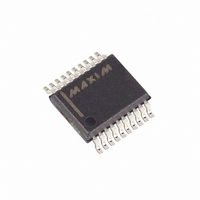MAX1667EAP+T Maxim Integrated Products, MAX1667EAP+T Datasheet - Page 10

MAX1667EAP+T
Manufacturer Part Number
MAX1667EAP+T
Description
IC SMART BATT CHGR LEVEL2 20SSOP
Manufacturer
Maxim Integrated Products
Datasheet
1.MAX1667EAPT.pdf
(26 pages)
Specifications of MAX1667EAP+T
Function
Charge Management
Battery Type
All Battery Types
Voltage - Supply
7.5 V ~ 28 V
Operating Temperature
-40°C ~ 85°C
Mounting Type
Surface Mount
Package / Case
20-SSOP
Lead Free Status / RoHS Status
Lead free / RoHS Compliant
Chemistry-Independent,
Level 2 Smart Battery Charger
Figure 3. Typical Single Smart Battery System
A smart battery charging system, at a minimum, con-
sists of a smart battery and smart battery charger com-
patible with the Smart Battery System specifications
using Intel’s system management bus (SMBus).
A system may use one or more smart batteries. The
block diagram of a smart battery charging system
shown in Figure 3 depicts a single battery system. This
is typically found in notebook computers, video cam-
eras, cellular phones, and other portable electronic
equipment.
Another possibility is a system that uses two or more
smart batteries. A block diagram for a system featuring
multiple batteries is shown in Figure 4. The smart bat-
tery selector is used to connect batteries to either the
smart battery charger or the system, or to disconnect
them, as appropriate. For a standard smart battery, the
following connections must be made: power (the bat-
10
Smart Battery Charging System
______________________________________________________________________________________
Smart Battery System Block Diagrams
SYSTEM HOST
(SMBus HOST)
+12V, -12V
BATTERY DATA/STATUS REQUESTS
V
CC
CRITICAL EVENTS
SYSTEM
POWER
SUPPLY
DC (UNREGULATED) / V
SMART BATTERY
CHARGING VOLTAGE/CURRENT
CRITICAL EVENTS
BATTERY
REQUESTS
V
SAFETY
SIGNAL
BATTERY
tery’s positive and negative terminals), SMBus (clock
and data), and safety signal (resistance, typically tem-
perature dependent). Additionally, the system host
must be able to query any battery in the system so it
can display the state of all batteries present in the sys-
tem.
Figure 4 shows a two-battery system where Battery 2 is
being charged while Battery 1 is powering the system.
This configuration may be used to “condition” Battery
1, allowing it to be fully discharged prior to recharge.
Two types of smart battery chargers are defined: Level
2 and Level 3. All smart battery chargers communicate
with the smart battery using the SMBus; the two types
differ in their SMBus communication mode and in
whether they modify the charging algorithm of the
smart battery as shown in Table 1. Level 3 smart bat-
tery chargers are supersets of Level 2 chargers and as
such support all Level 2 charger commands.
SMART BATTERY
CONTROL
MAX1667
CHARGER
SYSTEM
POWER
Smart Battery Charger Types
DC (UNREGULATED)
SMBus
(UNREGULATED)
CONVERTER
AC-DC
AC












